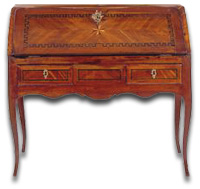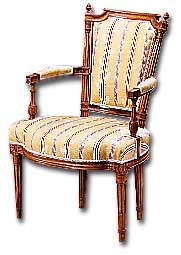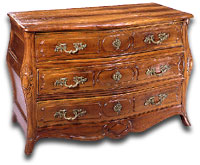During the reigns of Louis XV and Louis XVI, a deluge of furniture was produced by Parisian and Provincial ébénistes (artisans specializing in veneered furniture) and menuisiers (artisans specializing in carved furniture).
Ever since, these ornate works have been highly prized; today, a priviledged few private collectors and museums from around the globe vie for premium pieces at premium prices.
French furniture never goes out of style. There’s always been a market for this furniture, and there always will be. It’s harder to sell in a recession, but in general, it remains highly sought after.
Provenance is clearly very important, with celebrity and historic factors adding to market value.
Obviously the intrigue of owning a piece that belonged to Marie Antoinette is not only the celebrity value but the fact that it is the highest possible quality.


A Louis XV slant-front bureau, circa 1760
How much is Louis XV And XVI Furniture?
As for value, in 1998 a previously unknown Martin Carlin porcelain-mounted writing table — reputed to have been found in an attic — was sold by Sotheby’s for $2.9.
In Monaco in April, 2000, Christie’s held a single-owner sale of Karl Lagerfeld’s collection of French furniture and art garnering $21,654,181 — the second highest result ever achieved for a sale of this type.
Lagerfeld’s top lots went for:
- Louis XVI mahogany Armoire by Jean-Henri Riesener — $494,492
- Louis XV Savonnerie Carpet — $861,452
- Louis XVI Gueridon by Martin Carlin — $1,075,512
- Louis XV Vase — $1,121,382
Back on earth, a simpler piece of servants’ quarters furniture, even with a palace stamp, might go as for as little as a few thousand dollars, and a single small Provincial chair or miniature commode can be found for under $1,000.
Beds, tables and pairs of chairs can be found for under $5,000; armoires range around $10,000. (A stamped piece would bring up to 10 percent to 25 percent above these values.)


A Louis XVI gilt-bronze mounted mahogany console desserte, late 18th-century.
Marks of Distinction
While often unmarked, pieces from this era can boast a variety of known stamps. We recommend scrutinizing photographs of these stamps — including lettering and the way each is branded into the wood. You have to be very careful — there are a lot of fakes out there.
Worn stamps can be illegible. Often more detail will be revealed if you take a pencil-on-paper rubbing of the area.
Stamps often go unnoticed; it’s not unheard of for a stamp to be discovered during an auction preview, even on important pieces.
To look for marks:
- Shine a flashlight on it at an angle; if the light hits it in the right way, the stamp pops out.
- On commodes, look under the marble or on the upper corners of the back framework.
- On Parisian chairs, stamps are often on the rear seat rail, underneath the webbing and upholstery (and often worn away by upholstery tacks).
- On small tables, look on the underside of small drawers.
- On Provincial pieces, look on the rear seat rail or on the leg.


A Louis XVI beechwood fauteuil, late 18th-century.
Going to the source
Aside from auctions and reputable dealers, passionate collectors may choose to go to the source. Hotel Drouot, the famed Parisian auction house, conducts a variety of auctions simultaneously. Visit their online Gazette for a schedule of upcoming auctions (currently, the site is offered only in French).
Shops and local auctions in the Paris environs may produce results and a surprising number of pieces can be found in England, having been avidly purchased at steep discounts after the Revolution.
Condition and Restoration
It’s better to restore than not to restore — if the piece warrants the investment. Some of the best dealers will have something restored within an inch of its life — and that’s okay. They’re selling a look that’s very pristine, glossy and high-end.
Restorers should be accustomed to handling high caliber, highly-valued property. Get references from museums or auction houses on area restorers. It’s important that he or she be able to speak knowledgably about the furniture and the related techniques.
The more owners a piece has had, the higher the probability of damage. We recommend feeling along a veneered piece with one’s hands seeking signs of bubbling and warping.
Only if damage is heavy can you spot it with the eye, and this kind of restoration can be very involved.
Be careful when cleaning that you don’t tear it more with a rag.


A Louis XV provincial walnut commode, mid-18th century.
On the other hand, it’s not a big deal to have a little bit of loss on the veneer, especially in a less visible area.
We also suggest removing drawers to examine the quality of the dovetailing, and examine the bases of legs or feet for splicing. Feet and legs should also be checked for worming.
If a piece is missing an ormolu mount, such as a little sabot on the foot, replacement parts can be made.
We can recommend P.E. Guerin & Co. in New York, a manufacturer of gilt bronze replacement mounts. It uses a 24k gold electroplating process (mercury gilding is toxic and causes mercury poisoning).
With rips in tapestry, a specialist must remove and reweave the area using the exact same color and consistency of threads.
Heavy pieces of broken marble must be bracketed with supports across the break; smaller pieces may be glued.
Gilt is often worn and chipped away due to air pockets between the wood and gesso, caused by natural shrinkage over time. Depending on the extent of damage, a good restorer specializing in gilding and painting can either fill in the areas of loss or completely re-gild or re-paint a piece.
These time-consuming works preserve a valuable tradition, yet demand is small. Not only do they cost nearly as much as an original Louis XV or XVI piece, but they lack that certain je ne sais quoi that only time and history can bestow.
Further Reading:
French Furniture Makers: The Art of the Ebeniste from Louis XIV to the Revolution by Alexandre Pradere, Perran Wood
French Furniture: From Louis XIII to Art Deco by Sylvie Chadenet
Louis XV And XVI Furniture: Definitions
During the reign of Louis XV (1723-1774), influences from the previous Régence period were lavishly embellished upon by Parisian furniture-makers, resulting in a voluptuous, unrestrained style.
This ornate furniture is characterized by scrolling lines, cabriole legs and unrestrained ornamental carving and decoration.
Natural design motifs including foliage, flowers, birds, rocks and shells are seen everywhere — in the painted furniture, marquetry inlaid furniture and bronze ormolu (heavy cast bronze mounts done with the mercury gilding process).
Other forms of ornamentation included Chinese themes known as “Chinoiserie” and Chinese lacquered panels mounted on furniture. Seat furniture was generally upholstered in tapestry, or silk damask with large floral and pastoral scenes as the dominant design elements.
Around 1760, a demand for simpler forms and straighter lines ushered in the Transitional period. During the reign of Louis XVI (1774-1793), a departure from things representative of the previous monarch continued this trend, rendering Louis XVI furniture more restrained and linear.
A new emphasis on classical motifs echoed the ancient art and architecture unearthed in Greek and Roman ruins excavated at the time.
Louis XVI furniture exhibits tapered legs and simpler forms, with design elements including symmetrical borders of laurel and acanthus leaves, egg-and-dart, and fretwork.
Other popular motifs included bound arrows, lyres, swans, urns, and wreaths. Seat furniture was generally upholstered in silk or cotton with small printed motifs or stripes. Much of this furniture was made by sons of the craftsmen of Louis XV’s reign.
For both Louis XV and XVI furniture, Parisian cabinetmakers imported the finest exotic woods for their upscale clients, including royalty. You’ll see a lot of gilding and elaborate woodwork such as marquetry (organic, figurative, lacking straight lines) and parquetry (geometric and more linear).
Taking advantage of special properties of certain woods such as tulipwood and satinwood, veneers were often book-matched, with precisely matched pieces with identical striations placed in radiating designs and geometric forms.
Provincial furniture of both periods, made in the countryside and small towns, is generally simpler and more subdued — but equally beautiful.
This more accessible furniture is often solid wood (no veneer, no bronze, no gilding), with more of a focus on regional woods. In the provinces, furniture was generally carved with symbolic motifs of flora and fauna, including flowers, fruit, vines, wheat, fish and birds.
Instead of the usual scroll foot, a cabriole leg might end with a carved goat’s hoof.
Though not as lavish, Provincial furniture is still easily recognizable as belonging to one of the two Louis genres.
The designs were primarily influenced by the Louis XV period with organic, fluid, scrolling lines; the influence of the Louis XVI period can be seen in the introduction of new carving motifs such as musical instruments, urns, tureens, and ears of corn.
Prominent Woods Used in Louis XV and XVI Furniture
Parisian Carcasses: Oak and Pine
Parisian Veneers (Including Marquetry and Parquetry): Acajou (mahogany), Amaranth, Boulle, Boxwood, Citron, Ebony, Holly, Kingwood, Lime, Maple, Marquetry (tortoiseshell and brass), Palissandre (rosewood), Purplewood, Sycamore, Tulipwood
Parisian Mounts: Ormolu, Pietra Dura (Hardstones), Porcelain Plaques,
Provincial Carcasses: Ash, Beech, Birch, Cherrywood, Chestnut, Linden, Mulberry, Olivewood, Pearwood, Pine, Elm, Walnut, Willow
Stamps on Louis XV and XVI Furniture
The following stamps can be found on some Louis XV and XVI pieces:
A traditional maker’s mark from one of the multitude of Parisian and Provincial furniture-makers.
The JME (Jurande de Menuisiers et Ébénistes) stamp, an assay mark from the wardenship for the Parisian furniture-makers guild (the Corporation des Menuisiers-Ébénistes).
The highly-prized palace mark is extremely rare, and the appearance of one causes a ripple throughout the collecting community. Each palace had a unique mark (see references).
Occasionally, very plain functional pieces turn up with the palace stamp; these would have been made for use in the palace servants’ quarters.
On rare occasions the bronze is marked as well. A crowned “C” appears on some bronzes in accordance with a Royal Edict (1745-1749), indicating that a duty had been paid by the craftsman or dealer. It’s very rare to find this mark, and it was sometimes faked in the 19th century.
However, if the mark is authentic it’s one of the most precise ways of dating a piece of furniture from the 18th century.
Related Feature Stories
Cane Wicker & Rattan Furniture
News, Information & Buying Guides on Antique Furniture




